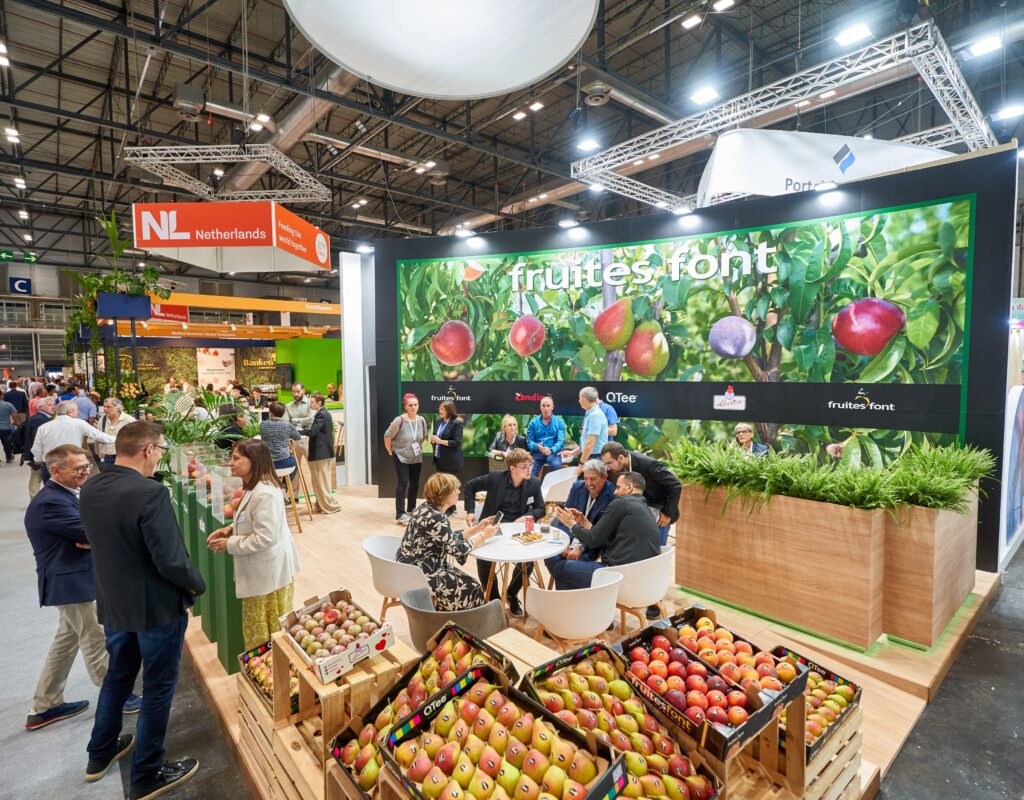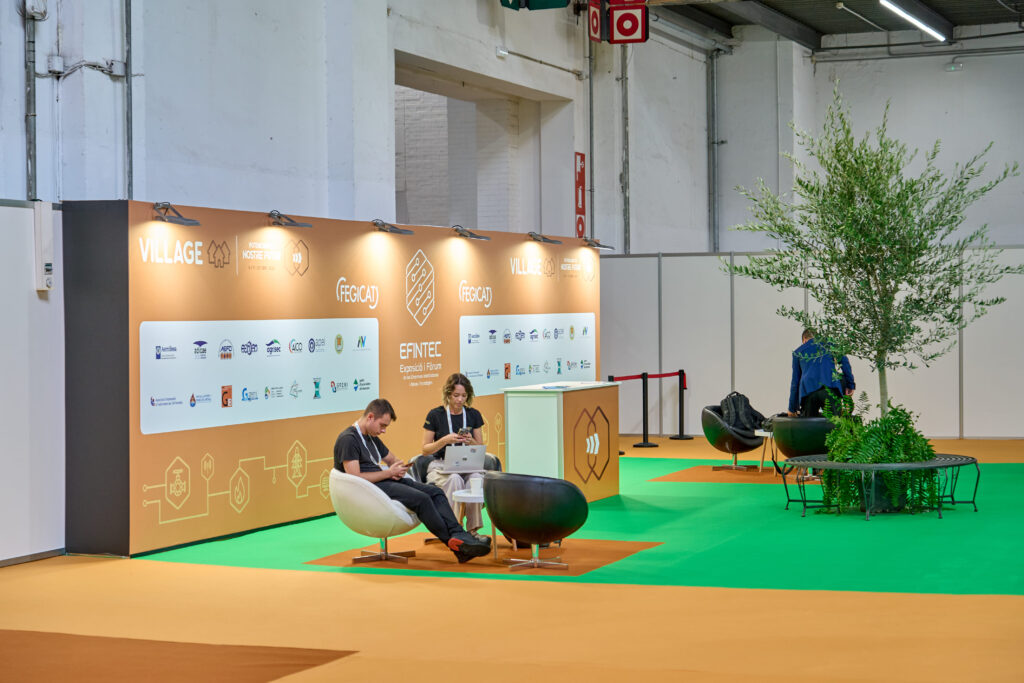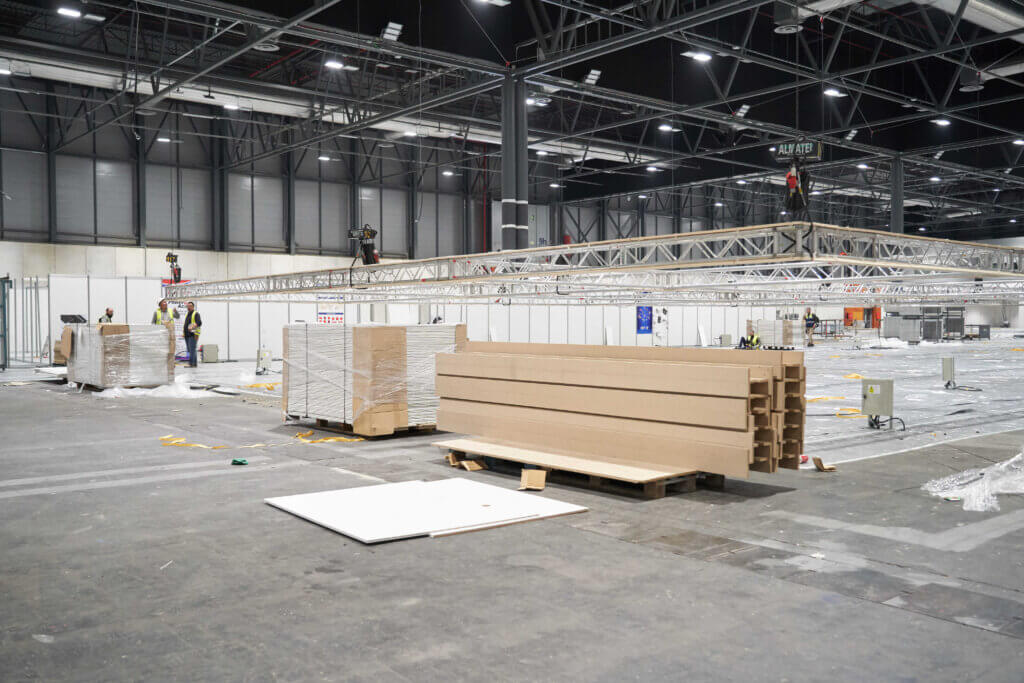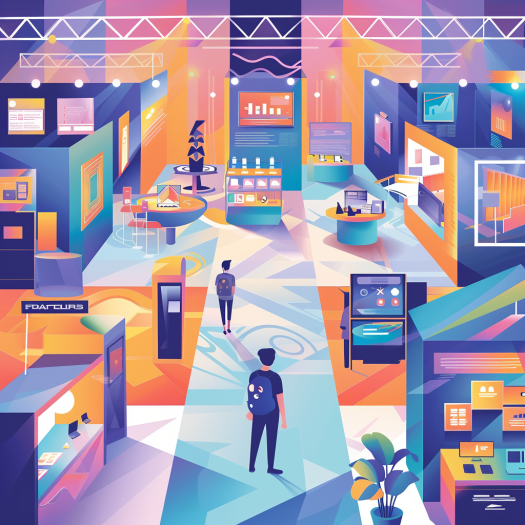How is the decoration like for booths at food trade shows?

How to design booth decorations for food trade shows? The decoration of booths for food fairs makes the difference between going unnoticed or capturing everyone’s attention. A good design should not only highlight the product but also create a welcoming atmosphere that invites people to taste and explore further. Table of contents In this post, we explore how booth decoration for food fairs can be the key to attracting and captivating the audience. From creating an ambiance that reflects the origin of the product to designing accessible spaces for tastings, we analyze the elements that make a booth stand out at a food fair. Additionally, we discuss how features like lighting, sustainable materials, and sensory experiences can enhance the visitor experience, ensuring your brand leaves a lasting impression. Booth decoration for food fairs is not just a showcase; it’s your best chance to make visitors stop, look, and want to know more. When it comes to edible products, the goal is to create a space that sparks an irresistible desire to taste and enjoy. After all, that’s what the fair is all about: captivating and connecting. Booth decoration for food fairs: putting the product in the spotlight At a food fair, booth decoration revolves around one main goal: putting the product in the spotlight. If your booth showcases something edible, the mission is clear: first, spark the desire to taste it, and then, inspire visitors to learn more about your brand. This means creating a comfortable and accessible space where samples are easy to see, without causing overcrowding (no endless lines—we want smooth, enjoyable visits!). For instance, imagine the impact of a screen showcasing how the product is made, where it comes from, and what makes it unique. This not only grabs attention but also encourages visitors to linger a little longer and delve deeper into what you have to offer Key elements in booth decoration for food fairs: 1. Theme and ambiance Transport visitors to the product’s origin: If your product comes from a special region or has an artisanal process, design your booth to create a connection with that story. You could recreate a local market or a rustic atmosphere, using natural materials and details that evoke its place of origin. Materials that convey quality: Wood, glass, and organic elements not only enhance the décor but also communicate authenticity. In the end, a well-thought-out setting makes your product look even more appealing. 2. Lighting that highlights the essentials Lights to highlight: Well-placed spotlights are essential to make your products shine—literally. Warm or directed LED lighting can create an inviting atmosphere that encourages exploration. Do you have questions about your participation in a trade show? Get our free consultation! 3. Comfortable and functional furniture: A space where people want to stay: Comfortable seating? Absolutely! Adding a few chairs and tables makes visitors feel welcome, increasing the chances they’ll stay longer. Displays that tell a story: Well-placed shelves or counters help showcase products attractively, while a clean design reinforces your brand image. 4. Eye-catching visual elements Graphics and screens that tell the story: Use large visuals and clear graphics to share your product’s story and highlight its strengths. The key is to communicate without overwhelming, ensuring every detail has purpose. Attention-grabbing colors: Your color palette should align with your brand while being bold enough to catch the eye from a distance. 5. Sensory experiences Tastings and enticing aromas: Scent plays a crucial role too. If you can offer samples, make sure they smell amazing. A pleasant aroma combined with a small tasting is a magnet for visitors. Genuine interaction: Beyond great decoration, it’s essential for staff to engage warmly, sharing what makes the product special and creating an experience that resonates with the audience. 6. Sustainability that’s visible and tangible Recyclable and natural materials: Using sustainable elements not only adds ethical value but also gives your booth a modern and appealing touch. Plus, today’s audience appreciates responsible brands—don’t miss out on that advantage! Your booth at a food fair: your best calling card Booth decoration for food fairs isn’t just about style—it’s about strategy. A well-designed booth creates a connection with visitors, sparks curiosity, and leaves a lasting impression. If you need help making your space at the next food fair unforgettable, at Servis we know how to make every detail matter. Let’s talk and take your booth to the next level! BOOTH EXAMPLES
Trade show spaces

Common areas at trade shows: What they are and how to design them Common areas at trade or professional shows aren’t limited to booths. These are the places where attendees can relax, socialize, and recharge—both physically and digitally. From rest zones to networking areas, these spaces play a crucial role in making the trade show experience more enjoyable and effective. Table of contents In this article, we examine the importance of common areas at trade and professional shows and how they influence the attendee experience. From conference theatres to rest zones, we explore which types of spaces are key in any trade show, their role, and how common areas should be designed to ensure comfort and smooth flow When we think of spaces at trade or professional shows, the first thing that comes to mind is usually booths filled with products and people discussing business. However, common areas at professional trade shows also play a key role. These are the places where we recharge our energy (and our phones), grab a coffee, or have a quick chat. Let’s explore how these spaces at trade shows can make a difference, not only in keeping the event running smoothly but also in making the experience much more enjoyable. Types of common areas at trade shows At a trade show, not everything happens at the booths. Common areas are key spots where attendees do a bit of everything, from taking a break to closing a deal. Some of the most common ones include: Stages For talks and conferences. A perfect place to learn something new or get inspired by industry leaders. Rest areas and lounges Spaces designed for attendees to relax, recharge, and network in a more informal setting Food and catering areas Where you can grab that much-needed coffee or enjoy a quick lunch. These are the most popular social spots. Outdoor areas or gardens: Outdoor spaces that provide a breath of fresh air and a connection with nature. Mobile device charging stations For talks and conferences. The perfect place to learn something new or get inspired by top professionals. Do you have questions about your participation in a trade show? Get our free consultation! Bleachers Seating areas where attendees can enjoy presentations or activities, especially useful at large trade shows. Restrooms Essential spaces that should be well-located and accessible to everyone. Medical assistance area To ensure the safety and well-being of attendees, especially at large events. Press area A dedicated space for the media, where they can conduct interviews or work without interruptions. Why are common areas key at professional or trade shows? Trade show spaces are not just areas to pass through. They are often the places where the real magic happens. Important conversations, essential breaks, and the time attendees need to catch their breath amidst all the activity. The best part is that each space has its specific function: to connect, rest, or stay informed about what’s going on Functional Design and Personal Space When designing these spaces at trade shows, there’s something we can’t forget: personal space. Let’s be honest, no one wants to feel cramped while trying to enjoy a talk or have a coffee. The key is to ensure a comfortable space for each person, allowing them to move around easily and enjoy the event without feeling overwhelmed. In networking areas, for example, the important thing is having enough space to move around, along with high tables and accessible power outlets (because, let’s be honest, you always need to charge your phone). In rest areas, what we’re looking for is comfort: cozy sofas and chairs, a relaxed atmosphere, and plenty of space so everyone can unwind without any hassle. Innovation and sustainability in trade show spaces Today, trade show spaces not only need to be functional but also sustainable. Opting for a modular and reusable design is an excellent choice. It not only saves time and money but also helps reduce environmental impact. Additionally, natural materials like recycled wood or plants can bring a fresh touch to any common area without compromising functionality. Connectivity Trade show spaces are also the perfect place to promote connectivity among attendees. Placing information screens in common areas ensures that no one misses what’s happening elsewhere at the event, while also keeping everyone informed about upcoming activities. And while we’re at it, why not use these areas to gather feedback? Setting up tablets or quick surveys is an easy way to collect valuable insights without overly disrupting the attendee experience.
What kind of flooring can I use for a trade show booth?

What flooring should I use for a trade show booth? Choosing the right flooring for your trade show booth is essential for creating an attractive and functional space that stands out from the crowd. The flooring you select should not only complement your booth’s design but also withstand heavy foot traffic and provide comfort for your visitors. Table of contents In this article, we explore the various flooring options for trade show booths and how each can enhance the aesthetics and functionality of your exhibition space. From traditional carpet to laminate flooring and vinyl surfaces, we analyze the features, advantages, and drawbacks of each type of flooring. We also emphasize the importance of considering accessibility for people with reduced mobility, and how expert advice can help you select the best option for your event. With this guide, you’ll be better equipped to choose flooring that not only looks great but also provides comfort and durability, ensuring your booth leaves a lasting impression on visitors. Types of flooring for trade show booths When designing a trade show booth, one of the most important aspects to consider is the type of flooring you’ll use. The right choice can enhance the aesthetics, functionality, and overall experience for visitors. Below, we present the most common options and their key features. 1. Carpet: A comfortable classic Carpet remains a popular option for trade show booth flooring, thanks to its ability to create a warm and welcoming atmosphere. It’s available in synthetic fibers, such as artificial grass, as well as natural fibers like sisal or coconut. Although it’s harder to clean, it’s ideal for areas where visitors are expected to spend a lot of time. Advantages: Comfort: Carpet provides a soft and comfortable surface to walk on, which can make visitors feel more relaxed and willing to stay longer at your booth. Variety of colors and textures: You can choose from a wide range of colors and textures, allowing you to customize your booth to match your brand’s image. Disadvantages: Maintenance: Carpet can be difficult to clean, especially if the booth is at a multi-day event with heavy foot traffic. Stains and dirt can accumulate quickly. Durability: While some carpets are quite durable, others may wear down over time, especially in high-traffic areas. 2. Vinyl Flooring (PVC): the most durable trade show booth flooring Vinyl flooring is another highly popular option, especially for trade show booths expecting a large number of visitors. This material is known for its durability and ease of maintenance. Advantages: Durability: PVC is extremely wear-resistant, making it an ideal choice for high-traffic areas. Easy to clean: Unlike carpet, vinyl flooring is much easier to keep clean, which is crucial for multi-day events. Variety of styles: This type of flooring comes in a wide range of designs and finishes, including wood, stone, and other material imitations, allowing you to achieve a high-end look without the associated cost. Disadvantages: Aesthetics: While there are many finishes available, some may consider it less elegant compared to materials like laminate or real wood. Do you have questions about your participation in a trade show? Get our free consultation! 3. Laminate Flooring: elegance and durability Laminate flooring is an option that combines a sophisticated look with the durability needed for a trade show environment. It’s made up of layers of wood fiber and resin, giving it the appearance of natural wood but with greater resistance to wear and impact. Advantages: Appearance: Laminate flooring offers an elegant, professional look similar to real wood, which can elevate the perceived quality of your booth. Durability: It’s more resistant to scratches and wear than natural wood, making it suitable for trade show environments with constant foot traffic. Easy to install: Laminate flooring is relatively easy to install and dismantle, which is a major advantage for events where setup and breakdown times are limited. Disadvantages: Water resistance: While durable, laminate flooring can be damaged by large amounts of water, so care should be taken in environments where spills might occur. Comfort: Although it provides a luxurious look, it doesn’t offer the same softness underfoot as carpet. Raised platform: Unlike the other flooring types, laminate usually requires a raised platform, which can increase the overall cost. Accessibility and functionality in trade show booths A crucial aspect often overlooked when designing a booth is accessibility. If your design includes platforms or raised areas, it’s essential to ensure they are accessible to people with reduced mobility. Ramps and easy-access areas not only comply with legal regulations but also ensure that all visitors have a comfortable, barrier-free experience. In addition, raised areas can be strategically used to conceal wiring and other technical elements, keeping the booth clean and organized. Always consider including clear and accessible signage to guide visitors, ensuring they have a positive experience at your booth. Raised platform: enhance your booth’s functionality and aesthetics A raised platform is an essential component for any trade show booth, not only for enhancing the look and visibility of the space but also for the practical benefits it provides: Cable and pipe management: A raised platform is crucial when you need to discreetly run cables, pipes, or other technical elements. Its elevated structure allows you to conceal these components, keeping the booth clean and well-organized. Base for laminate flooring: If you choose laminate flooring, a raised platform becomes even more important. It provides a stable, even surface for the laminate, ensuring its durability and maintaining a professional appearance throughout the event. Differentiation and visibility: Elevating the booth with a platform improves visibility, helping your space stand out from others and creating a more exclusive, attractive atmosphere. Comfort and safety: The platform also allows for the selection of materials that enhance visitor comfort, such as anti-slip finishes, and ensures a safe surface for everyone. Accessibility: It’s essential that the platform includes ramps or other access solutions for people with reduced mobility, ensuring compliance with all accessibility regulations. How to choose the best flooring for my trade show booth? Choosing
Most commonly used exhibition stand materials

Exhibition stand materials: most popular options and how to choose If you’re wondering what the best exhibition stand materials are, you’re in the right place! It’s not just about how they look—it’s also about practicality. The right materials should be easy to work with, durable, and able to handle the fast-paced environment of a trade show. In this post, we’ll walk you through the most commonly used materials and help you decide which one is the best fit for your next booth Table of contents When it comes to setting up a trade show booth, choosing the right exhibition stand materials makes all the difference. Wood is a timeless classic—versatile and warm. If you’re looking for something lighter, aluminum, PVC, or foam are great options, especially for building large structures without the added weight. Want a modern look? Glass is perfect for creating open, well-lit spaces. And for those finishing touches, materials like paper, cardboard, and fabric can add personality and detail to your design. With the right mix, your booth won’t just be functional—it’ll be a real showstopper. Why your choice of material affects every aspect of your booth The material you choose for your exhibition stand isn’t just a secondary detail—it’s a strategic decision. The right choice can make a big difference in several key areas: Brand image: Wood conveys warmth and exclusivity, aluminum suggests modernity and lightness, and backlit fabric communicates innovation. Logistics: Lightweight materials reduce transport costs and speed up setup, while others may require more time and specialized labor. Cost: Some materials are more budget-friendly but may not deliver the same visual impact. Sustainability: More and more trade shows are setting sustainability requirements, and exhibition stand materials must comply with environmental standards or certifications. The three most common ways to build your exhibition stand If you want to understand which exhibition stand materials are used at trade shows, the first step is to look beyond just a list of options. Everything starts with the three main ways to build a stand Carpentry (wood and wood-based materials) Custom-built (wood and wood-based materials) This is the most common option for fully customized exhibition stands. It involves working with wood and its derivatives to create entirely tailor-made structures. Advantages: complete creative freedom, high-end finishes, and the ability to fully integrate custom furniture. Drawbacks: longer setup times, potentially higher costs if not planned for reuse, and generally less sustainable. Common finishes: melamine, water-based paint, printed vinyl, stapled canvas, polypropylene carpet, 3D textured or backlit panels. Types of wood used in exhibition stands: plywood, MDF, laminated pine, and particleboard. Reusable modular systems Reusable modular systems These systems are made up of pre-designed, interchangeable components—typically aluminum profiles and panels—that can be assembled in different configurations. Advantages: quick and easy to install, reusable for multiple events, lightweight and easy to transport, more sustainable. Drawbacks: less flexibility in terms of shapes and design, and the final look may be less unique or premium. Common finishes: fabric graphics, printed panels, PVC, and LED lighting integrated into the structure. If you’d like to learn more about modular stands, you can do so at this link: modular stands Hybrid solutions These combine the best of both worlds: a modular structure for faster setup and easier transport, plus custom-built elements in key areas that require greater visual impact. Advantages: a balanced mix of customization and efficiency. Drawbacks: more complex planning and coordination. Popular exhibition stand materials and how they’re used In addition to wood and aluminum, exhibition stands often incorporate other materials that enhance both aesthetics and functionality: Printed vinyl: Used to brand walls and furniture with custom graphics that reflect your identity. Printed fabric: Ideal for large backdrops or lightweight ceilings, with the option for backlighting. Acrylic (PMMA): Adds a modern, transparent look, commonly used in display cases and showcases. PVC: Widely used for signage and panels, though it’s increasingly being replaced by PVC-free alternatives. Recycled carpet: Covers floors and raised platforms; easy to install and more eco-friendly. Foam board: Lightweight and cost-effective, perfect for signage and graphic elements. Eco-friendly materials for your exhibition stand Sustainability has become a must-have criterion at most trade shows. These are some of the most eco-friendly materials used in exhibition stands: FSC- or PEFC-certified wood – Ensures responsible forest management and traceability. Reusable aluminum structures – Built for long-term use over multiple events. PVC-free fabrics – A recyclable alternative to traditional vinyl banners. Recycled and recyclable carpets – Help reduce environmental impact and comply with waste regulations. Modular and reusable panels – Designed to be dismantled and stored without generating waste. But beyond the materials themselves, sustainability also depends on the stand’s full life cycle—how it’s transported, assembled, dismantled, and what happens to it after the event. A good supplier should provide a clear plan for reuse or recycling. Current trends in exhibition stand materials The trade show industry is shifting toward more sustainable and versatile solutions: Replacing PVC with recyclable fabrics and panels Using large-format backlit textiles for high visual impact Designing furniture for multiple uses instead of single-event setups Premium modular systems that deliver a custom-designed look Recycled surface finishes that combine visual appeal with environmental responsibility Conclusion Exhibition stand materials aren’t just a technical detail—they’re the foundation of the entire project. Your choice of materials will impact the design, cost, sustainability, and overall visitor experience. Custom-built carpentry remains the best choice for unique, tailor-made stands. Modular systems are ideal for multi-event use thanks to their reusability and low environmental impact. Hybrid solutions offer the best of both worlds, combining flexibility and customization. If you want to get the most out of your trade show investment, it’s best to find the right combination of materials that reflect your brand identity while meeting today’s standards for sustainability and reuse. We also recommend using our new Visual Wall system to calculate how much your stand could cost.
Types of trade show booths

Types of trade show booths: choose the best one for your brand Trade show booths are a vital tool for making your brand stand out at fairs and exhibitions. Choosing the right type can make a big difference in the visibility and success of your participation. From modular trade show booths to custom options, discover how each type can enhance your presence at any event. Table of contents Portable booths are cost-effective and easy to transport, making them ideal for companies with tight budgets or small spaces, such as trade shows in hotels or exhibitions in shopping centers. Modular booths offer great value for money and are standardized, which makes them practical but less distinctive. Lastly, custom booths allow for full customization, creating unique environments that draw visitors’ attention. The cost of these booths varies depending on the level of customization. Modular Trade Show Booths Modular trade show booths typically have a standardized square or rectangular shape throughout the venue and are well-equipped. They offer great value for money, but they don’t provide much room to stand out from the competition. Customization is limited. Advantages of Modular Trade Show Booths Great value for money: Compared to custom trade show booths, modular booths are generally more cost-effective in terms of both manufacturing and installation. They don’t require prior preparation, as they usually come equipped with everything needed. Disadvantages of Modular Trade Show Booths Design limitations: Prefabricated modules can restrict the layout and design of the booth, limiting creativity and innovation compared to custom booths. Less exclusivity: Since many companies use modular booths, they may lack the exclusivity and originality that some brands seek for their trade show presentations. Limited customizatio: While setup can be quick, configuring and customizing the modules is quite restricted; for example, you typically can’t screw anything into the walls, among other limitations. Custom Trade Show Booths Custom trade show booths offer complete personalization and create a remarkable visual impact, clearly standing out from the competition. They are typically built with materials like wood, metal, and glass, allowing for high-quality finishes, striking appearances, and unique booth designs. Advantages of Custom Trade Show Booths: High Customization: Custom booths allow for complete adaptation, meaning every detail can be tailored to reflect the brand’s identity and values, as well as showcase the exhibitor’s products or services. This includes the selection of materials, colors, shapes, and exclusive designs. Material Versatility: These booths can utilize a wide range of materials, such as wood, metal, glass, and fabrics, allowing for the creation of unique textures and finishes. This versatility not only enhances the booth’s aesthetics but also improves its functionality. Visual Impact: With their unique and creative design, these booths typically generate a stronger visual impact on visitors. They can feature innovative elements like custom lighting, large-format graphics, AV displays, and eye-catching architectural structures that draw attention. Do you have doubts about your participation in a trade show? Request our free consultation! REQUEST NOW Disadvantages of custom booths: Cost to manage: Their design and construction come with countless variables, making them difficult to budget for. However, they can be tailored to fit your budget. Custom booths are usually more expensive than other types. Complexity: They can be more complicated to assemble and disassemble, often requiring specialized personnel. In some cases, companies with limited production capacity may need to outsource both assembly and production, making management more challenging. For this reason, it’s advisable to work with companies that offer a full service, from design to final teardown. Portable trade show booths Los stands portátiles son soluciones económicas y prácticas para ferias y eventos en hoteles, centros comerciales…etc. Consisten en soportes gráficos ligeros, como banners o displays pop-up de tipo paraguas, que son fáciles de transportar y montar. Ideales para empresas con presupuestos ajustados, estos stands permiten una instalación rápida y sencilla, aunque su durabilidad y espacio de exhibición son más limitados en comparación con otras opciones. Advantages of portable booths: Easy to transport: They are lightweight and easy to move, which reduces shipping and logistics costs. Quick setup: Typically easy to assemble and disassemble, without the need for specialized tools or technical staff. Versatility: They adapt to different spaces and events, allowing for reuse at multiple trade shows. Reusable: Exhibitors can purchase and reuse them multiple times, handling the assembly, disassembly, and storage themselves. Disadvantages of portable booths: Visual impact: Less eye-catching and customizable than other types of stands, which may make it harder to stand out at trade shows. Load capacity: The lightweight structure may not support heavy loads, limiting the amount and type of equipment or products that can be displayed. Reduced customization: While they offer some flexibility, portable stands don’t allow the same level of customization as modular or custom stands, which can limit design and branding options. Own staff: Your own staff is needed for setup and takedown, as well as for storing and maintaining the stand.
